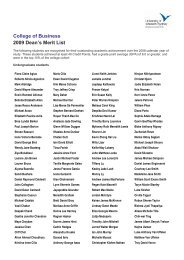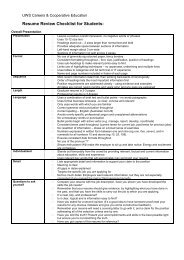Mate-selection and the Dark Triad - University of Western Sydney
Mate-selection and the Dark Triad - University of Western Sydney
Mate-selection and the Dark Triad - University of Western Sydney
You also want an ePaper? Increase the reach of your titles
YUMPU automatically turns print PDFs into web optimized ePapers that Google loves.
Personality <strong>and</strong> Individual Differences 51 (2011) 759–763Contents lists available at ScienceDirectPersonality <strong>and</strong> Individual Differencesjournal homepage: www.elsevier.com/locate/paid<strong>Mate</strong>-<strong>selection</strong> <strong>and</strong> <strong>the</strong> <strong>Dark</strong> <strong>Triad</strong>: Facilitating a short-term mating strategy<strong>and</strong> creating a volatile environmentPeter K. Jonason a,⇑ , Ka<strong>the</strong>rine A. Valentine b , Norman P. Li b , Carmelita L. Harbeson ca <strong>University</strong> <strong>of</strong> South Alabama, Department <strong>of</strong> Psychology, Mobile, AL 36688, United Statesb School <strong>of</strong> Social Sciences, 90 Stamford Road, Level 4, Singapore 178903, Singaporec <strong>University</strong> <strong>of</strong> West Florida, Department <strong>of</strong> Biology, Pensacola, FL 32514, United StatesarticleinfoabstractArticle history:Received 7 May 2011Received in revised form 17 June 2011Accepted 23 June 2011Available online 22 July 2011Keywords:<strong>Dark</strong> <strong>Triad</strong><strong>Mate</strong> preferencesBudget-allocationPersonalityThe current study (N = 242) seeks to establish <strong>the</strong> relationship between traits known collectively as <strong>the</strong><strong>Dark</strong> <strong>Triad</strong> – narcissism, psychopathy, Machiavellianism – <strong>and</strong> mating st<strong>and</strong>ards <strong>and</strong> preferences. Using abudget-allocation task, we correlated scores on <strong>the</strong> <strong>Dark</strong> <strong>Triad</strong> traits with mate preferences for a longterm<strong>and</strong> short-term mate. Men scoring high on <strong>the</strong> <strong>Dark</strong> <strong>Triad</strong> may be more indiscriminate than mostwhen selecting for short-term mates in order to widen <strong>the</strong>ir prospects. Fur<strong>the</strong>rmore, those high on <strong>the</strong><strong>Dark</strong> <strong>Triad</strong> – psychopathy in particular – tend to select for mates based on self-interest, assortative mating,or a predilection for volatile environments. We assessed <strong>the</strong>se correlations when controlling for <strong>the</strong>Big Five <strong>and</strong> <strong>the</strong> sex <strong>of</strong> <strong>the</strong> participant. We also tested for moderation by <strong>the</strong> sex <strong>of</strong> <strong>the</strong> participant <strong>and</strong>mating context. Ramifications <strong>and</strong> future directions are considered.Ó 2011 Published by Elsevier Ltd.1. IntroductionRecent work on <strong>the</strong> <strong>Dark</strong> <strong>Triad</strong> (Paulhus & Williams, 2002) has revealedthat this constellation <strong>of</strong> three traits – narcissism, psychopathy,<strong>and</strong> Machiavellianism – linked by a core <strong>of</strong> disagreeableness(Jakobwitz & Egan, 2006; Paulhus & Williams, 2002), may not beas maladaptive as traditionally considered (Kowalski, 2001) <strong>and</strong>are even heritable (Vernon, Villani, Vickers, & Harris, 2008). The <strong>Dark</strong><strong>Triad</strong> seems to constitute an impulsive, aggressive, <strong>and</strong> opportunisticsocial style that may facilitate an exploitative – yet effective –short-term mating strategy (Jonason, Li, Webster, & Schmitt, 2009;Jones & Paulhus, 2010). Indeed, being high on <strong>the</strong> <strong>Dark</strong> <strong>Triad</strong> traitsis, especially for men, associated with being sociosexually unrestricted,having had more sex partners, currently seeking short-termmates (Foster, Shrira, & Campbell, 2006; Jonason et al., 2009), <strong>and</strong>being apt to poach those already in relationships (Jonason, Li, & Buss,2010b). Despite <strong>the</strong>se insights, nothing is known yet about <strong>the</strong> matingst<strong>and</strong>ards <strong>and</strong> mate preferences <strong>of</strong> such individuals.A key dynamic in short-term mating is that women tend to bemore reluctant than men are to engage in this type <strong>of</strong> behavior.For instance, from zero-acquaintance all <strong>the</strong> way up until 5 years<strong>of</strong> acquaintance, men are significantly more willing to engage insexual relations than women are (Buss & Schmitt, 1993). Around<strong>the</strong> world, men report being more sociosexually unrestricted thanwomen do (Schmitt, 2005). In a classic field study, an opposite-sex⇑ Corresponding author.E-mail address: pjonason@usouthal.edu (P.K. Jonason).stranger approached students on campus <strong>and</strong> propositioned <strong>the</strong>mfor a sexual encounter. Although over 70% <strong>of</strong> men agreed, not onewoman consented (Clark & Hatfield, 1989).Given women’s reluctance towards casual sex <strong>and</strong> that bothsexes prioritize physical attractiveness over o<strong>the</strong>r traits in casualsex partners (Li & Kenrick, 2006), men who successfully pursue ashort-term mating strategy may need to be ei<strong>the</strong>r especially physicallyattractive or have relatively low mating st<strong>and</strong>ards. Indeed,men tend to have lower overall st<strong>and</strong>ards than women do for casualsexual partners (Kenrick, Groth, Trost, & Sadalla, 1993). To<strong>the</strong> extent <strong>the</strong> <strong>Dark</strong> <strong>Triad</strong> traits are centered on short-term matingirrespective <strong>of</strong> individuals’ physical attractiveness, we may expectmen who are high on <strong>Dark</strong> <strong>Triad</strong> traits to have lower st<strong>and</strong>ards forshort-term mates than men who are not high on <strong>Dark</strong> <strong>Triad</strong> traits.By having low st<strong>and</strong>ards, those high on <strong>the</strong> <strong>Dark</strong> <strong>Triad</strong> may create atarget-rich mating environment.Women, however, tend to be similarly selective for both long<strong>and</strong>short-term mates (Kenrick et al., 1993; Li & Kenrick, 2006).As a function <strong>of</strong> <strong>the</strong> fact that men tend to be eager for casual sex,women do not have to lower <strong>the</strong>ir st<strong>and</strong>ards in order to attract ashort-term mate (Symons, 1979). Thus, <strong>the</strong> same distinction wouldnot apply for high-<strong>Dark</strong> <strong>Triad</strong> versus low-<strong>Dark</strong> <strong>Triad</strong> women.Therefore, we predict men who are high on <strong>the</strong> <strong>Dark</strong> <strong>Triad</strong> willhave particularly low st<strong>and</strong>ards in <strong>the</strong>ir short-term mates; <strong>and</strong>we predict this pattern to hold up across all three <strong>of</strong> <strong>the</strong> <strong>Dark</strong> <strong>Triad</strong>traits given <strong>the</strong> near-uniform correlations between <strong>the</strong> <strong>Dark</strong> <strong>Triad</strong>traits <strong>and</strong> numerous measures <strong>of</strong> short-term mating (Jonason et al.,2009).0191-8869/$ - see front matter Ó 2011 Published by Elsevier Ltd.doi:10.1016/j.paid.2011.06.025
760 P.K. Jonason et al. / Personality <strong>and</strong> Individual Differences 51 (2011) 759–763People’s personalities allow <strong>the</strong>m to create or ‘‘select’’ <strong>the</strong> environmentsin which <strong>the</strong>y engage (Buss, 1984a, 1987). Individualsmay actively structure <strong>the</strong>ir environment through mate-choice;mate-choice being an important <strong>selection</strong>-domain (Buss, 1984a,1987; Hamilton, 1964). A common effect in mate <strong>selection</strong> is assortativemating – people tend to match <strong>the</strong>mselves up with o<strong>the</strong>rs onspecific characteristics (Buss & Barnes, 1986; Kenrick et al., 1993)like <strong>the</strong> Big Five (Buss, 1984b). The <strong>Dark</strong> <strong>Triad</strong> traits are correlatedwith disagreeableness (Paulhus & Williams, 2002), aggressiveness(Bushman & Baumeister, 1998), criminality (Hare, 1996), <strong>and</strong>manipulativeness (Christie & Geis, 1970) – qualities, we would argue,are directly opposite to kindness. In addition, <strong>the</strong>se individualshave a high need for stimulation (Jones & Paulhus, 2010) <strong>and</strong> risktaking(Jonason, Koenig, & Tost, 2010a; Jonason & Tost, 2010); <strong>the</strong>ymay actually not place a high premium on kindness because <strong>the</strong>ywish to create a volatile environment to stimulate <strong>the</strong>mselves.Therefore, we predict scores on <strong>the</strong> <strong>Dark</strong> <strong>Triad</strong> traits would be negativelycorrelated with preferences for kindness in mates. However,given that psychopathy is correlated with risk-taking above<strong>the</strong> o<strong>the</strong>r traits (Jonason et al., 2010a), we expect this correlationto be localized to psychopathy when we control for variability in<strong>the</strong> o<strong>the</strong>r two.<strong>Mate</strong> <strong>selection</strong> is not a new topic in social-personality psychology.We know that both <strong>the</strong> Big Five <strong>and</strong> <strong>the</strong> sex <strong>of</strong> <strong>the</strong> participantare important variables in underst<strong>and</strong>ing matepreferences <strong>and</strong> <strong>selection</strong>. The <strong>Dark</strong> <strong>Triad</strong> tends to be correlatedwith all parts <strong>of</strong> <strong>the</strong> Big Five (Jakobwitz & Egan, 2006; Paulhus &Williams, 2002), <strong>and</strong> men tend to score higher on <strong>the</strong> threetraits than women do (Jonason & Kavanagh, 2010; Jonason &Webster, 2010; Jonason et al., 2009). In order to avoid <strong>the</strong> ‘‘janglefallacy’’ 1 we checked our results by partialling <strong>the</strong> varianceassociated with <strong>the</strong> sex <strong>of</strong> <strong>the</strong> participant in explaining mate preferences,<strong>and</strong> <strong>the</strong>n partialling <strong>the</strong> variance associated with <strong>the</strong> BigFive in explaining mate preferences in line with prior work (Jonasonet al., 2009).The <strong>Dark</strong> <strong>Triad</strong> traits tend not to be correlated with interestin long-term relationships (Jonason & Webster, 2010; Jonasonet al., 2009). However, human societies are characterized bylong-term mateships, <strong>and</strong> monogamy is held out as a sociallydesirable state <strong>and</strong> is socially enforced to some degree (Kanazawa& Still, 1999; McDonald, 1995). In response to such socioecologicalconditions, individuals who score high on <strong>the</strong> <strong>Dark</strong> <strong>Triad</strong>may still engage in medium- or long-term pair-bonding (Campbell& Foster, 2002). In accordance with prior work (Jonason &Kavanagh, 2010; Jonason et al., 2009, 2010b), we examined <strong>the</strong>manner in which <strong>the</strong> <strong>Dark</strong> <strong>Triad</strong> traits operate in both shortterm<strong>and</strong> long-term contexts. Based on past research on matepreferences <strong>and</strong> recent studies that implicate <strong>the</strong> <strong>Dark</strong> <strong>Triad</strong> asaligned with a short-term mating strategy, we expected st<strong>and</strong>ardsfor short-term mates to be lowest for men scoring higheston <strong>the</strong> <strong>Dark</strong> <strong>Triad</strong>. We also investigated how <strong>the</strong>se traits leadindividuals to structure <strong>the</strong>ir environment to be consistent with<strong>the</strong>ir personality traits in both mating contexts.2.1. ParticipantsTwo hundred <strong>and</strong> forty-two psychology students (108 men; 134women), aged 17–53 years (M = 20.89, Median = 19, SD = 5.33) locatedin <strong>the</strong> Sou<strong>the</strong>rn US received partial course credit for fillingout <strong>the</strong> surveys described below. Ninety-three percent <strong>of</strong> <strong>the</strong> samplewas heterosexual, with 3% homosexual <strong>and</strong> 4% bisexual. Fortysevenpercent <strong>of</strong> <strong>the</strong> sample self-identified as ‘‘single’’ <strong>and</strong> <strong>the</strong>remaining 53% self-identified as ‘‘involved’’ (i.e., married or seriouslydating).2.2. Procedures <strong>and</strong> measuresParticipants completed <strong>the</strong> survey online. Only those participantsfrom unique IP addresses were included to insure <strong>the</strong>assumption <strong>of</strong> independence was not violated. The <strong>Dark</strong> <strong>Triad</strong>‘‘Dirty Dozen’’, a 12-item measure <strong>of</strong> <strong>the</strong> <strong>Dark</strong> <strong>Triad</strong> with four itemsper subscale, was used (Jonason & Webster, 2010). Participantswere asked to what extent <strong>the</strong>y agreed (1 = not at all, 5=verymuch) with statements such as: ‘‘I tend to want o<strong>the</strong>rs to admireme’’; ‘‘I tend to lack remorse’’; <strong>and</strong> ‘‘I have used deceit or lied toget my way.’’ Items were averaged toge<strong>the</strong>r to create an index <strong>of</strong>narcissism (Cronbach’s a = .84), Machiavellianism (a = .86), psychopathy(a = .74), <strong>and</strong> an aggregated index <strong>of</strong> all three (a = .90).The three traits were correlated with one ano<strong>the</strong>r between .49<strong>and</strong> .70 (p < .01). Men scored higher on <strong>the</strong>se measures than womendid on all three dimensions, but <strong>the</strong> sex differences werenot significant. 2To measure <strong>the</strong> Big Five, we used <strong>the</strong> Ten-Item PersonalityInventory (TIPI; Gosling, Rentfrow, & Swann, 2003), which askstwo questions for each dimension. Participants were asked, for instance,how much (1 = not at all,5=very much) <strong>the</strong>y think <strong>of</strong> <strong>the</strong>mselvesas ‘‘extraverted, enthusiastic’’ <strong>and</strong> ‘‘quiet, reserved’’(reverse-scored) as measures <strong>of</strong> extraversion. Estimates <strong>of</strong> internalconsistency returned low rates: extraversion (a = .48), agreeableness(a = .31), conscientiousness (a = .26), neuroticism (a = .31),<strong>and</strong> openness (a = .39), as is to be expected for scales composed<strong>of</strong> a small number <strong>of</strong> items (Kline, 2000); internal consistency estimatesare positively related to <strong>the</strong> number <strong>of</strong> scale items (Carmines& Zeller, 1979). Never<strong>the</strong>less, because we sought tocontrol for variability in <strong>the</strong> Big Five <strong>and</strong> not to directly study <strong>the</strong>Big Five, we proceeded.To measure mate preferences <strong>and</strong> st<strong>and</strong>ards, we used a set <strong>of</strong>traits from previous mate preference papers (Li, Bailey, Kenrick,& Linsenmeier, 2002; Li & Kenrick, 2006; Li, Valentine, & Patel,2011) – social level, creativity, kindness, liveliness, <strong>and</strong> physicalattractiveness (presented in that order, from left to right). For botha long- <strong>and</strong> short-term mate (counterbalanced), participants provided<strong>the</strong>ir minimum accepted decile (10th percentile, 20th percentile,etc.) for each trait by ticking <strong>the</strong>ir answers. Participantswere told to treat each decile as indicative <strong>of</strong> <strong>the</strong> quality <strong>of</strong> a hypo<strong>the</strong>ticalmate. For instance, a mate who was in <strong>the</strong> 10th decile wasin <strong>the</strong> bottom 10% <strong>of</strong> o<strong>the</strong>r potential mates in terms <strong>of</strong> that trait.2. MethodWe examined how men <strong>and</strong> women’s overall st<strong>and</strong>ards forlong- <strong>and</strong> short-term mates related to <strong>the</strong>ir scores on <strong>the</strong> <strong>Dark</strong><strong>Triad</strong>. In addition, we examined correlations between <strong>the</strong> <strong>Dark</strong><strong>Triad</strong> <strong>and</strong> mate preferences where we control for <strong>the</strong> Big Five<strong>and</strong> <strong>the</strong>n <strong>the</strong> sex <strong>of</strong> <strong>the</strong> participant. Last, we tested for moderationby <strong>the</strong> mating context <strong>and</strong> by <strong>the</strong> sex <strong>of</strong> <strong>the</strong> participant.3. ResultsWe first ran a General Linear Model analysis using SPSS withtrait <strong>selection</strong>s as <strong>the</strong> dependent variable. Trait <strong>and</strong> duration (i.e.,long-term, short-term) were within-subjects variables <strong>and</strong> participants’sex was a between-subjects variable. <strong>Dark</strong> <strong>Triad</strong> compositescores were entered as a continuous between-subjects variable(i.e., covariate in SPSS). There was an interaction <strong>of</strong> duration sex <strong>Dark</strong> <strong>Triad</strong> (F(1, 234) = 5.87, p < .05, g 2 p= .02). To inter-1 Introducing a new variable that is a clone <strong>of</strong> ano<strong>the</strong>r (Block, 2000).2 This limitation prohibited us from doing mediation analyses.
P.K. Jonason et al. / Personality <strong>and</strong> Individual Differences 51 (2011) 759–763 761pret this interaction, we performed a median split 3 <strong>of</strong> <strong>the</strong> <strong>Dark</strong><strong>Triad</strong> composite variable <strong>and</strong> reran <strong>the</strong> analysis. The interactionwas still significant (F(1, 234) = 5.43, p < .05, g 2 p= .02). As shown inFig. 1, both sexes had equally high overall st<strong>and</strong>ards for long-termmates, <strong>and</strong> this was true for both low- <strong>and</strong> high-<strong>Dark</strong> <strong>Triad</strong> individuals;however, men had somewhat lower st<strong>and</strong>ards than women didfor short-term mates. In particular, men who were high on <strong>Dark</strong><strong>Triad</strong> traits had even lower st<strong>and</strong>ards than men who were low on<strong>the</strong>se traits did (F(1, 234) = 4.14, p < .05, g 2 p= .02). This confirmsour primary prediction that those men who are high on <strong>the</strong> <strong>Dark</strong><strong>Triad</strong> will have mate preferences that facilitate a short-term matingstrategy by providing numerous opportunities to engage in said matings.When we repeated this analysis, with all <strong>the</strong> individual <strong>Dark</strong><strong>Triad</strong> traits entered as covariates, only two significant interactionswere found: psychopathy (F(1, 234) = 2.13, p < .05, g 2 p= .07) <strong>and</strong>Machiavellianism (F(1, 234) = 2.33, p < .05, g 2 p= .09). The effect wasnot significant for narcissism.Table 1 contains <strong>the</strong> zero-order correlations <strong>and</strong> <strong>the</strong> st<strong>and</strong>ardizedregression coefficients predicting mate preferences. Theinclusion <strong>of</strong> multiple regression analysis wherein all three <strong>of</strong><strong>the</strong> <strong>Dark</strong> <strong>Triad</strong> traits are entered as predictors <strong>of</strong> mate preferencesallows us to assess <strong>the</strong> unique contributions <strong>of</strong> each <strong>of</strong><strong>the</strong> <strong>Dark</strong> <strong>Triad</strong> traits independently, while controlling for sharedvariability with <strong>the</strong> o<strong>the</strong>rs. Generally speaking, <strong>the</strong> <strong>Dark</strong> <strong>Triad</strong>was uncorrelated with mate preferences. However, <strong>the</strong> <strong>Dark</strong><strong>Triad</strong> was linked to <strong>the</strong> creation <strong>of</strong> a mating environment thatis composed to limited kindness through psychopathy, consistentwith our prediction.3.1. Avoiding <strong>the</strong> Jangle FallacyWe controlled for <strong>the</strong> collective influence <strong>of</strong> <strong>the</strong> Big Five. The <strong>Dark</strong><strong>Triad</strong> composite was correlated with preferences <strong>of</strong> a long-termmate who was physically attractive (pr(235) = .15, p < .05) remainednegatively correlated with preference for a short-term mate whowas kind (pr(235) = .17, p < .05), suggesting this correlation wasrobust to <strong>the</strong> partialling <strong>of</strong> <strong>the</strong> Big Five, <strong>and</strong> was negatively correlatedwith preferences for a short-term mate who was creative(pr(235) = .17, p < .05). Narcissism was positively correlated withpreference for long-term mates who were physically attractive(pr(235) = .18, p < .05) <strong>and</strong> have high social level (pr(235) = .15,p < .05). Psychopathy remained negatively correlated with kindnesspreferences in long-term mates (pr(235) = .19, p < .01), suggestingthis correlation was robust to <strong>the</strong> partialling <strong>of</strong> <strong>the</strong> Big Five.When we partialled <strong>the</strong> variance associated with <strong>the</strong> sex <strong>of</strong> <strong>the</strong>participant much <strong>of</strong> our results with <strong>the</strong> <strong>Dark</strong> <strong>Triad</strong> remained significant.Psychopathy was still correlated with preferences for shorttermmates (pr(235) = .21, p < .01) 4 <strong>and</strong> was negatively correlatedwith preference for long-term mates who were kind (pr(235) = .20,p < .01). Narcissism was correlated with preferences for long-termmates who had high social level (pr(235) = .16, p < .05) <strong>and</strong> negativelycorrelated with preference for short-term mates who were creative(pr(235) = .22, p < .01) <strong>and</strong> kind (pr(235) = .14, p < .05). Machiavellianismwas negatively correlated with preferences for short-termmates who were creative (pr(235) = .13, p < .05). The <strong>Dark</strong> <strong>Triad</strong>composite was correlated with lower preferences for short-termmates who were creative (pr(235) = .18, p < .01) <strong>and</strong> kind(pr(235) = .17, p < .01).3 Gr<strong>and</strong> Mean = 2.02, Gr<strong>and</strong> Median = 1.92, Gr<strong>and</strong> SD = 0.74; Female Mean = 1.94,Female Media = 1.83, Female SD = 0.75; Male Mean = 2.11, Male Median = 1.96, MaleSD = 0.73.4 This is suppression. Similar suppression has been reported in previous work(Jonason & Kavanagh, 2010).Fig. 1. Long- <strong>and</strong> short-term mating st<strong>and</strong>ards (average minimum acceptabledecile) for individuals with high versus low <strong>Dark</strong> <strong>Triad</strong> scores.3.2. ModerationBy examining <strong>the</strong> correlations across mating durations we wereable to determine if <strong>the</strong> correlations between <strong>the</strong> <strong>Dark</strong> <strong>Triad</strong> differedby mating duration <strong>and</strong> <strong>the</strong> sex <strong>of</strong> <strong>the</strong> participant. We conducteda series <strong>of</strong> Fisher’s z-tests 5 (Cohen, Cohen, West, & Aiken,2003). As a result <strong>of</strong> <strong>the</strong> limited evidence for moderation, we donot include full correlation matrices. These can be obtained by contacting<strong>the</strong> first author. What we found (z’s |1.65| to |2.24|, p’s < .05),was noted by subscripts in <strong>the</strong> Table. Generally speaking, <strong>the</strong> moderationby mating context was localized to narcissism <strong>and</strong> was generallynegative or nil in <strong>the</strong> context <strong>of</strong> short-term mating <strong>and</strong>positive or nil in <strong>the</strong> context <strong>of</strong> long-term mating.Results also suggest even more limited moderation by <strong>the</strong> sex <strong>of</strong><strong>the</strong> participant, likely <strong>the</strong> result <strong>of</strong> diminished power as per disaggregatedcorrelations. As such we did not include <strong>the</strong> correlationmatrix by <strong>the</strong> sex <strong>of</strong> <strong>the</strong> participant but this can be obtained bycontacting <strong>the</strong> first author. For <strong>the</strong> trait <strong>of</strong> social level in long-termmates, narcissism (z = 1.96, p < .05) was positively correlatedwith allocation-rates in men (r = .25, p < .05) but not in women(r = .01).4. DiscussionResults suggest those who are high on <strong>the</strong> <strong>Dark</strong> <strong>Triad</strong> traits createadvantageous environments for short-term mating by having agenerally lower set <strong>of</strong> st<strong>and</strong>ards in <strong>the</strong>ir mates as shown in Fig. 1.By not being particularly choosey, those who are characterized by5 This is considered <strong>the</strong> most liberal test for moderation (Baron & Kenny, 1986). Ourfailure to find much evidence for moderation even with this liberal test suggestsmoderation is not particularly strong for <strong>the</strong> sex <strong>of</strong> <strong>the</strong> participant nor mating context.
762 P.K. Jonason et al. / Personality <strong>and</strong> Individual Differences 51 (2011) 759–763Table 1Zero-order correlations <strong>and</strong> multiple regression coefficients for <strong>the</strong> associations between <strong>the</strong> <strong>Dark</strong> <strong>Triad</strong> <strong>and</strong> mate preferences across long-term <strong>and</strong> short-term mates along withmoderation tests by mating context.r (beta)Psychopathy Narcissism Machiavellianism <strong>Dark</strong> triadLong-term mate preferencesSocial level .03 ( .15) .12 (.18) .09 b (.06) .09 cCreativity .11 ( .10) .08 ( .05 g ) .08 (.02) .11Kindness .21 ** ( .26 ** ) .04 (.05 f ) .08 (.05) .12Liveliness .10 ( .17 * ) .06 a (.15 e ) .00 ( .01 h ) .01Physical attractiveness .05 (.00) .12 (.17 d ) .06 ( .06) .10Short-term mate preferencesSocial level .13 ( .11) .05 (.07) .10 b ( .08) .10 cCreativity .10 ( .00) .22 ** ( .25 ** g) .13 * (.04) .18 **Kindness .22 ** ( .23 ** ) .17 ** ( .13 f ) .12 (.12) .19 **Liveliness .10 ( .13) .10 a ( .12 e ) .03 (.14 h ) .08Physical attractiveness .02 ( .01) .02 ( .02 d ) .03 ( .01) .03Note: Comparisons among subscript letters are significant (p < .05) moderation tests using <strong>the</strong> Fisher’s z-test for moderation effects by mating duration.* p < .05.** p < .01.high rates <strong>of</strong> <strong>the</strong> <strong>Dark</strong> <strong>Triad</strong> traits may insure <strong>the</strong>y have ample supply<strong>of</strong> potential short-term mates. This is consistent with past researchsuggesting <strong>the</strong> <strong>Dark</strong> <strong>Triad</strong> facilitates a short-term matingstrategy for men (Jonason et al., 2009). Alternatively, <strong>the</strong> lowerst<strong>and</strong>ards we found in men who are high on <strong>the</strong> <strong>Dark</strong> <strong>Triad</strong> couldrepresent a Plan B strategy where <strong>the</strong>y start with high st<strong>and</strong>ards(Plan A strategy) but are willing to lower <strong>the</strong>ir st<strong>and</strong>ards (Plan B)as an adaptive response to create more options in <strong>the</strong> mating poolwhen faced by rejection; rejection that may be a function <strong>of</strong> <strong>the</strong>irdisagreeable nature.Those high on psychopathy in particular devalued <strong>the</strong> traitkindness in <strong>the</strong>ir long- <strong>and</strong> short-term mates. Those high on <strong>the</strong><strong>Dark</strong> <strong>Triad</strong> traits may choose long- <strong>and</strong> short-term mates in orderto create a volatile environment (i.e., drama-rich) to appease <strong>the</strong>irhigh need for stimulation <strong>and</strong> impulsivity (Jonason et al., 2010a;Jones & Paulhus, 2010) as shown in Table 1. Alternatively, thosehigh on <strong>the</strong> <strong>Dark</strong> <strong>Triad</strong> may commit character-specific assortment(Buss & Barnes, 1986). The <strong>Dark</strong> <strong>Triad</strong> is correlated with all manner<strong>of</strong> ‘‘antisocial’’ personality traits like aggressiveness (Jonason &Webster, 2010) <strong>and</strong> criminality (Hare, 1996) <strong>and</strong> individuals highon <strong>the</strong> <strong>Dark</strong> <strong>Triad</strong> might accept <strong>the</strong>se traits in partners.The <strong>Dark</strong> <strong>Triad</strong> traits have proven to be a hot topic in researchon personality (Jakobwitz & Egan, 2006; Jones & Paulhus, 2010;Paulhus & Williams, 2002) <strong>and</strong> in <strong>the</strong> media (Bhattacharya, 2010;Jackman, 2008); however, it is important to avoid <strong>the</strong> ‘‘jangle fallacy’’(Block, 2000). To do so, we controlled for o<strong>the</strong>r sources <strong>of</strong> variabilitythat are related to mate preferences like <strong>the</strong> sex <strong>of</strong> <strong>the</strong>participant <strong>and</strong> <strong>the</strong> Big Five. Most notably, <strong>the</strong> negative correlationbetween kindness <strong>and</strong> psychopathy remains, suggesting <strong>the</strong> <strong>Dark</strong><strong>Triad</strong> does account for unique variance in mate preferences.These results may imply <strong>the</strong> Big Five might not be <strong>the</strong> only personalitytraits with important repercussions (McAdams, 1992;Stagner, 1994). In response to this realization, some have exp<strong>and</strong>ed<strong>the</strong> Big Five to include honesty <strong>and</strong> humility (Lee & Ashton, 2005);o<strong>the</strong>rs have focused on mating (Schmitt & Buss, 2000; Simpson &Gangestad, 1991) as important additions to our underst<strong>and</strong>ing <strong>of</strong>inter-individual variability. The <strong>Dark</strong> <strong>Triad</strong> may be an additionalcluster <strong>of</strong> personality traits that have important consequences.We explored moderation effects by mating context <strong>and</strong> <strong>the</strong> sex<strong>of</strong> <strong>the</strong> participant. The moderation effects for mating context werealmost exclusively localized to narcissism. In <strong>the</strong> context <strong>of</strong> shorttermmates, traits like creativity, kindness, <strong>and</strong> liveliness were alldevalued whereas in <strong>the</strong> context <strong>of</strong> long-term mates, traits likeliveliness <strong>and</strong> physical attractiveness were valued. There was onlyone significant moderation effect for <strong>the</strong> sex <strong>of</strong> <strong>the</strong> participant,suggesting narcissistic men care about long-term mates who havesocial status whereas females who are narcissistic do not. Seeingthat on average women care about long-term mates having sociallevel more than men do (Buss, 1989; Li et al., 2002), it seems wehave found one individual differences variable that reverses thissex difference; however, we used <strong>the</strong> most liberal test for moderation<strong>and</strong> thus <strong>the</strong>se results should be interpreted with caution<strong>and</strong> replicated. Generally, we found little evidence for moderationby ei<strong>the</strong>r <strong>the</strong> sex <strong>of</strong> <strong>the</strong> participant or mating context.This study had a number <strong>of</strong> limitations. First, one might questionour adoption <strong>of</strong> <strong>the</strong> Dirty Dozen. Although brief, this measuresis psychometrically stable, has moderate construct validity, <strong>and</strong>good convergent <strong>and</strong> divergent validity (Jonason & Webster,2010; Jonason et al., submitted for publication). Second, one mightquestion our use <strong>of</strong> <strong>the</strong> TIPI to control for o<strong>the</strong>r sources <strong>of</strong> variability(Miller et al., 2010). The Dirty Dozen does correlate with <strong>the</strong>agreeableness dimension <strong>of</strong> <strong>the</strong> TIPI suggesting that at least in thiscase it is reasonable to use <strong>the</strong>m both. In addition, because <strong>the</strong><strong>Dark</strong> <strong>Triad</strong> are related to numerous facets <strong>of</strong> <strong>the</strong> Big Five <strong>and</strong> <strong>the</strong>Big Five are all related to mating outcomes (Schmitt & Shackelford,2008), we felt it necessary to control for <strong>the</strong> whole <strong>of</strong> <strong>the</strong> Big Fivewhile not increasing subject fatigue while completing <strong>the</strong> budgetallocationtask where participants had to think in deciles. Never<strong>the</strong>less,future work might benefit from assessing <strong>the</strong>se correlationswith <strong>the</strong> longer measures <strong>of</strong> <strong>the</strong> <strong>Dark</strong> <strong>Triad</strong> <strong>and</strong> <strong>the</strong> BigFive. Third, <strong>the</strong> correlations between budget-allocations <strong>and</strong> <strong>the</strong><strong>Dark</strong> <strong>Triad</strong> traits were all ra<strong>the</strong>r small, never exceeding .25, <strong>and</strong>thus <strong>the</strong> magnitude <strong>of</strong> <strong>the</strong> relationships were modest at best.Fourth, we have only examined <strong>the</strong> allocation to five traits thathave been used in past budget-allocation studies <strong>and</strong> are essentialin mate preference studies, but <strong>the</strong>re are numerous o<strong>the</strong>r traitsthat individuals want in <strong>the</strong>ir mates (Buss, 1989). Surely, a studywith a more exhaustive list <strong>of</strong> traits desired in actual, not hypo<strong>the</strong>tical,mates should be done. Fifth, we speculated that psychopathymight be associated with creating a hostile environmentthrough mate choice; a prediction that deserves direct testing.Sixth, we have examined only two relationship contexts but moremight exist beyond ‘‘ideal types’’ (Manning, Giordano, & Longmore,2006, p. 462) like friends-with-benefits (Epstein, Calzo, Smiler, &Ward, 2009) <strong>and</strong> booty-call relationships (Jonason, Li, & Richardson,2010c).Prior research suggests <strong>the</strong> <strong>Dark</strong> <strong>Triad</strong> traits are important individualdifferences in accounting for a range <strong>of</strong> interpersonal <strong>and</strong>intrapersonal phenomena. They are heritable (Vernon et al.,2008), correlated with important criterion variables like number
P.K. Jonason et al. / Personality <strong>and</strong> Individual Differences 51 (2011) 759–763 763<strong>of</strong> sex partners (Jonason et al., 2009), <strong>and</strong> correlated with life outcomedata like risk-taking (Jonason, Koenig, & Tost, 2010a). In <strong>the</strong>present study, we have extended our underst<strong>and</strong>ing <strong>of</strong> <strong>the</strong> <strong>Dark</strong><strong>Triad</strong> by correlating <strong>the</strong>m with mate preferences. The <strong>selection</strong> <strong>of</strong>mates is an important context in which to underst<strong>and</strong> any personalitytrait (Buss, 1984a, 1987). In order to facilitate <strong>the</strong> short-termmating strategy in men that appears to be manifested in <strong>the</strong> <strong>Dark</strong><strong>Triad</strong> (Jonason, Li, & Buss, 2010b; Jonason et al., 2009), <strong>the</strong>se individualsmay create a ‘‘target-rich’’ environment by having lowst<strong>and</strong>ards in <strong>the</strong>ir mates. In addition, we have shown that thosehigh on psychopathy may create mating contexts that are volatile<strong>and</strong> choose mates who are similar to <strong>the</strong>m in terms <strong>of</strong> being low onkindness.ReferencesBaron, R. M., & Kenny, D. A. (1986). The moderator–mediator variable distinction insocial psychological research: Conceptual, strategic, <strong>and</strong> statisticalconsiderations. Journal <strong>of</strong> Personality <strong>and</strong> Social Psychology, 51, 1173–1182.Bhattacharya, S. (2010). What’s so right about Mr Wrong. Psychologies.Block, J. (2000). Three tasks for personality psychology. In L. R. Bergman, R. B. Cairns,L. Nilsson, & L. Nystedt (Eds.), Developmental science <strong>and</strong> <strong>the</strong> holistic approach(pp. 155–164). Mahwah, NJ: Erlbaum.Bushman, B. J., & Baumeister, R. F. (1998). Threatened egotism, narcissism, selfesteem,<strong>and</strong> direct <strong>and</strong> displaced aggression: Does self-love or self-hate lead toviolence? Journal <strong>of</strong> Personality <strong>and</strong> Social Psychology, 75, 219–229.Buss, D. M. (1984a). Toward a psychology <strong>of</strong> person-environment (PE) correlation:The role <strong>of</strong> spouse <strong>selection</strong>. Journal <strong>of</strong> Personality <strong>and</strong> Social Psychology, 47,361–377.Buss, D. M. (1984b). Marital assortment for personality dispositions: Assessmentwith three data sources. Behavior Genetics, 14, 111–123.Buss, D. M. (1987). Selection, evocation, <strong>and</strong> manipulation. Journal <strong>of</strong> Personality <strong>and</strong>Social Psychology, 53, 1214–1221.Buss, D. M. (1989). Sex differences in human mate preferences: Evolutionaryhypo<strong>the</strong>ses tested in 37 cultures. Behavioral & Brain Sciences, 12, 1–49.Buss, D. M., & Barnes, M. L. (1986). Preferences in human mate <strong>selection</strong>. Journal <strong>of</strong>Personality <strong>and</strong> Social Psychology, 50, 559–570.Buss, D. M., & Schmitt, D. P. (1993). Sexual Strategies Theory: An evolutionaryperspective on human mating. Psychological Review, 100, 204–232.Campbell, W. K., & Foster, C. A. (2002). Narcissism <strong>and</strong> commitment in romanticrelationships: An investment model analysis. Personality <strong>and</strong> Social PsychologyBulletin, 28, 484–495.Carmines, E. G., & Zeller, R. A. (1979). Reliability <strong>and</strong> validity assessment.Quantitative applications in <strong>the</strong> social sciences series (Vol. 17). Newbury Park,CA: Sage.Christie, R., & Geis, F. L. (1970). Studies in Machiavellianism. New York: AcademicPress.Clark, R. D., III, & Hatfield, E. (1989). Gender difference in receptivity to sexual <strong>of</strong>fers.Psychology <strong>and</strong> Human Sexuality, 2, 39–55.Cohen, J., Cohen, P., West, S. G., & Aiken, L. S. (2003). Applied multiple regression/correlation analysis for <strong>the</strong> behavioral sciences (3rd ed.). Mahwah, NJ: Erlbaum.Epstein, M., Calzo, J. P., Smiler, A. P., & Ward, L. M. (2009). ‘‘Anything from makingout to having sex’’: Men’s negotiations <strong>of</strong> hooking up <strong>and</strong> friends with benefits.The Journal <strong>of</strong> Sex Research, 46, 414–424.Foster, J. D., Shrira, L., & Campbell, W. K. (2006). Theoretical models <strong>of</strong> narcissism,sexuality, <strong>and</strong> relationship commitment. Journal <strong>of</strong> Social <strong>and</strong> PersonalRelationships, 23, 367–386.Gosling, S. D., Rentfrow, P. J., & Swann, W. B. Jr., (2003). A very brief measure <strong>of</strong> <strong>the</strong>Big-Five personality domains. Journal <strong>of</strong> Research in Personality, 37, 504–528.Hamilton, W. D. (1964). The genetical evolution <strong>of</strong> social behavior: I <strong>and</strong> II. Journal <strong>of</strong>Theoretical Biology, 7, 1–52.Hare, R. D. (1996). Psychopathy: A clinical construct whose time has come. CriminalJustice <strong>and</strong> Behavior, 23, 25–54.Jackman, P. (2008). Why bad boys get girls. Globe<strong>and</strong>Mail.Jakobwitz, S., & Egan, V. (2006). The dark triad <strong>and</strong> normal personality traits.Personality <strong>and</strong> Individual Differences, 2, 331–339.Jonason, P.K., Luévano, V.X., Kaufman, S.B., Adams, H.M., & Geher, G. (submitted forpublication). Shedding light on <strong>the</strong> <strong>Dark</strong> <strong>Triad</strong>: The validity <strong>and</strong> nomologicalnetwork <strong>of</strong> <strong>the</strong> Dirty Dozen.Jonason, P. K., & Kavanagh, P. (2010). The dark side <strong>of</strong> love: The <strong>Dark</strong> <strong>Triad</strong> <strong>and</strong> lovestyles. Personality <strong>and</strong> Individual Differences, 49, 606–610.Jonason, P. K., Koenig, B., & Tost, J. (2010a). Living a fast life: Psychopathy links <strong>the</strong><strong>Dark</strong> <strong>Triad</strong> to Life History Theory. Human Nature, 21, 428–442.Jonason, P. K., Li, N. P., & Buss, D. M. (2010b). The costs <strong>and</strong> benefits <strong>of</strong> <strong>the</strong> <strong>Dark</strong><strong>Triad</strong>: Implications for mate poaching <strong>and</strong> mate retention tactics. Personality<strong>and</strong> Individual Differences, 48, 373–378.Jonason, P. K., Li, N. P., & Richardson, J. (2010c). Positioning <strong>the</strong> booty-callrelationship on <strong>the</strong> spectrum <strong>of</strong> relationships: Sexual but more emotionalthan one-night st<strong>and</strong>s. The Journal <strong>of</strong> Sex Research, 47, 1–10.Jonason, P. K., Li, N. P., Webster, G. W., & Schmitt, D. P. (2009). The <strong>Dark</strong> <strong>Triad</strong>:Facilitating short-term mating in men. European Journal <strong>of</strong> Personality, 23, 5–18.Jonason, P. K., & Tost, J. (2010). I just cannot control myself: The <strong>Dark</strong> <strong>Triad</strong> <strong>and</strong> selfcontrol.Personality <strong>and</strong> Individual Differences, 49, 611–615.Jonason, P. K., & Webster, G. D. (2010). The Dirty Dozen: A concise measure <strong>of</strong> <strong>the</strong><strong>Dark</strong> <strong>Triad</strong>. Psychological Assessment, 22, 420–432.Jones, D. N., & Paulhus, D. L. (2010). Different provocations trigger aggression innarcissists <strong>and</strong> psychopaths. Social Psychological <strong>and</strong> Personality Science, 1,12–18.Kanazawa, S., & Still, M. C. (1999). Why monogamy? Social Forces, 78, 25–50.Kenrick, D. T., Groth, G. E., Trost, M. R., & Sadalla, E. K. (1993). Integratingevolutionary <strong>and</strong> social exchange perspective on relationships: Effects <strong>of</strong>gender, self-appraisal, <strong>and</strong> involvement level on mate <strong>selection</strong> criteria.Journal <strong>of</strong> Personality <strong>and</strong> Social Psychology, 64, 951–969.Kline, P. (2000). The h<strong>and</strong>book <strong>of</strong> psychological testing (2nd ed.). London: Routledge.Kowalski, R. M. (Ed.). (2001). Behaving badly: Aversive behaviors in interpersonalrelationships. Washington, DC: American Psychological Association.Lee, K., & Ashton, M. C. (2005). Psychopathy, Machiavellianism, <strong>and</strong> narcissism in<strong>the</strong> Five-Factor Model <strong>and</strong> <strong>the</strong> HEXACO model <strong>of</strong> personality structure.Personality <strong>and</strong> Individual Differences, 38, 1571–1582.Li, N. P., Bailey, J. M., Kenrick, D. T., & Linsenmeier, J. A. W. (2002). The necessities<strong>and</strong> luxuries <strong>of</strong> mate preferences: Testing <strong>the</strong> trade<strong>of</strong>fs. Journal <strong>of</strong> Personality<strong>and</strong> Social Psychology, 82, 947–955.Li, N. P., & Kenrick, D. T. (2006). Sex similarities <strong>and</strong> differences in preferences forshort-term mates: What, whe<strong>the</strong>r, <strong>and</strong> why. Journal <strong>of</strong> Personality <strong>and</strong> SocialPsychology, 90, 468–489.Li, N. P., Valentine, K. A., & Patel, L. (2011). <strong>Mate</strong> preferences in <strong>the</strong> U.S AndSingapore: A cross-cultural test <strong>of</strong> <strong>the</strong> mate preference priority model.Personality <strong>and</strong> Individual Differences, 50, 291–294.Manning, W., Giordano, P., & Longmore, M. (2006). Hooking up: The relationshipcontexts <strong>of</strong> ‘‘nonrelationship‘‘ sex. Journal <strong>of</strong> Adolescent Research, 21, 459–483.McAdams, D. P. (1992). The five-factor model in personality: A critical appraisal.Journal <strong>of</strong> Personality, 60, 329–361.McDonald, K. (1995). The establishment <strong>and</strong> maintenance <strong>of</strong> socially imposedmonogamy in <strong>Western</strong> Europe. Politics <strong>and</strong> <strong>the</strong> Life Sciences, 14, 3–23.Miller, J. D., Dir, A., Gentile, B., Wilson, L., Pryor, L. R., & Campbell, W. K. (2010).Searching for a vulnerable <strong>Dark</strong> <strong>Triad</strong>: Comparing factor 2 psychopathy,vulnerable narcissism, <strong>and</strong> Borderline Personality Disorder. Journal <strong>of</strong>Personality, 78, 1529–1564.Paulhus, D. L., & Williams, K. M. (2002). The dark triad <strong>of</strong> personality: Narcissism,Machiavellianism, <strong>and</strong> psychopathy. Journal <strong>of</strong> Research in Personality, 36,556–563.Schmitt, D. P. (2005). Sociosexuality from Argentina to Zimbabwe: A 48-nationstudy <strong>of</strong> sex, culture, <strong>and</strong> strategies <strong>of</strong> human mating. Behavioral <strong>and</strong> BrainSciences, 28, 247–275.Schmitt, D. P., & Buss, D. M. (2000). Sexual dimensions <strong>of</strong> person description:Beyond or subsumed by <strong>the</strong> Big Five? Journal <strong>of</strong> Research in Personality, 34,141–177.Schmitt, D. P., & Shackelford, T. K. (2008). Big Five traits related to short-termmating: From personality to promiscuity across 46 nations. EvolutionaryPsychology, 6, 246–282.Simpson, J., & Gangestad, S. (1991). Individual differences in sociosexuality:Evidence for convergent <strong>and</strong> discriminant validity. Journal <strong>of</strong> Personality <strong>and</strong>Social Psychology, 60, 870–883.Stagner, R. (1994). Traits <strong>and</strong> <strong>the</strong>oreticians. Psychological Inquiry, 5, 166–168.Symons, D. (1979). The evolution <strong>of</strong> human sexuality. New York: Oxford <strong>University</strong>Press.Vernon, P. A., Villani, V. C., Vickers, L. C., & Harris, J. A. (2008). A behavioral geneticsinvestigation <strong>of</strong> <strong>the</strong> <strong>Dark</strong> <strong>Triad</strong> <strong>and</strong> <strong>the</strong> Big 5. Personality <strong>and</strong> IndividualDifferences, 44, 445–452.


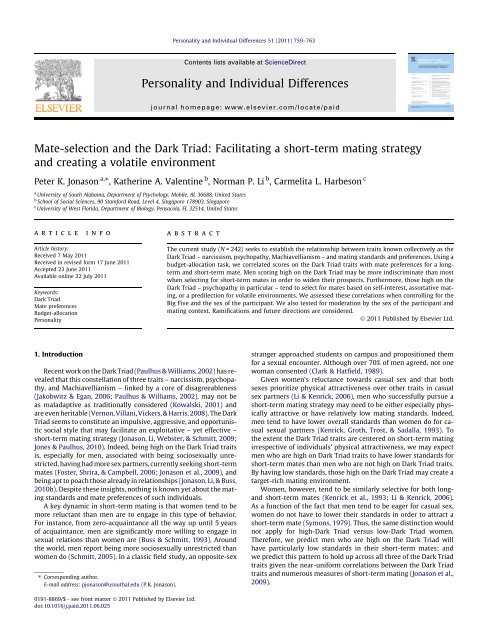

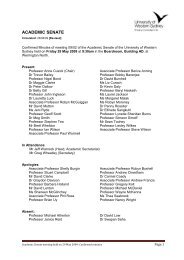
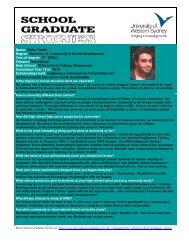
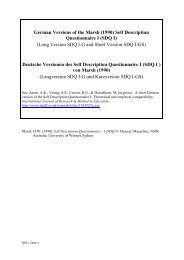
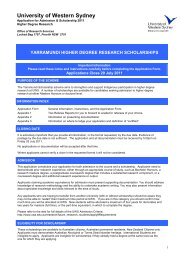
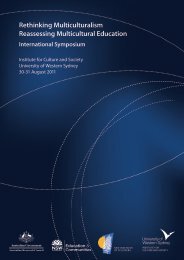

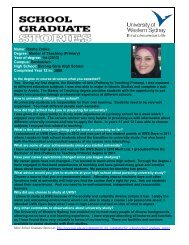
![Glossary of terms for Academic Integration Plans [PDF, 127Kb]](https://img.yumpu.com/46838287/1/184x260/glossary-of-terms-for-academic-integration-plans-pdf-127kb.jpg?quality=85)

